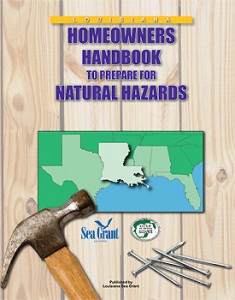Homeowners Hazards Handbook Available at Hurricane Preparedness Meeting
 Free copies of the Louisiana Homeowners Handbook to Prepare for Natural Hazards will be available at the City of Slidell Hurricane Preparedness Meeting, June 13 at 6 p.m. in city council chambers, 2045 Second Street.
Free copies of the Louisiana Homeowners Handbook to Prepare for Natural Hazards will be available at the City of Slidell Hurricane Preparedness Meeting, June 13 at 6 p.m. in city council chambers, 2045 Second Street.
The handbook explains the forces of nature that act on structures during storms, including the dangers associated with high winds, heavy rain and storm surge. It further lays out ways to gird a home against these forces to minimize or negate their effects, as well as provides information on how to reduce the human toll exacted by dangerous storms. The book also offers information specific to Louisiana for preparing evacuation plans and kits, construction practices, retrofitting, shutter styles, insurance information and emergency contact numbers.
A download of the handbook also is available at www.laseagrant.org/sglegal/publications/other/homeowners-handbook/
Louisiana Sea Grant produced the handbook with the help of other state, regional and national organizations. The handbook was funded through a program of the Gulf of Mexico Alliance (GOMA), which aims to see each Gulf state prepare its own guidelines for coastal residents. With recent storms – including Hurricanes Katrina and Rita in 2005, Hurricane Gustav in 2008, and the Mississippi River flooding in 2011 – being among the worst in memory, preparing beforehand for a natural hazard has become even more important for residents of vulnerable areas.
Since its establishment in 1968, Louisiana Sea Grant (www.laseagrant.org) has worked to promote stewardship of the state’s coastal resources through a combination of research, education and outreach programs critical to the cultural, economic and environmental health of Louisiana’s coastal zone. Louisiana Sea Grant, based at Louisiana State University, is part of the National Sea Grant College Program, a network of 33 university-based programs in each of the U.S. coastal and Great Lakes states and Puerto Rico.
